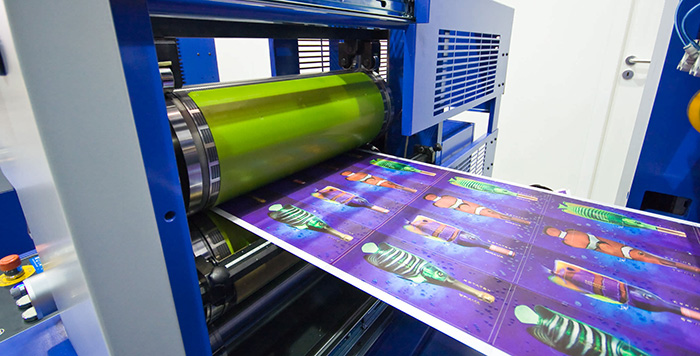What is offset printing?

Offset printing, also known as offset lithography, is a mass-production printing process in which the image from a metal plate is transferred (offset printing) to a blanket or roller, and then transferred to the printing medium. The printing medium, usually paper, does not make direct contact with the metal plate. This extends the life of the plate. In addition, the flexible rubber easily ADAPTS to the surface of the printed media, allowing the process to be used effectively on media with rough surfaces such as canvas, cloth or wood. Offset printing’s main advantage is its high and stable image quality. The process can be used for small, medium or large quantities of work.
Today, two types of offset presses are commonly used for publishing: sheetfed offset and web offset. In sheet offset, a single sheet is fed into a machine. These pages can be pre-cut to final publication size or trimmed after printing. In web offset printing, larger, higher speed machines are used. The machines are fed into large paper reels, where individual pages are separated and trimmed later. Sheetlet offset printing is very popular in small and medium sized stationary work, such as limited edition books. Web offset printing is more cost-effective for high-volume publications whose content often changes, such as metropolitan newspapers.
How Does Offset Printing Work?
Offset printing process used in the first cylinder is the “plate” cylinder. This thin roller has a plastic or aluminum plate around it. Each plate is customized according to the words and images to be printed on the paper. The plate cylinder has been pretreated so that the image can attract ink and repel water. As the plate cylinder rotates, it comes into contact with rollers that apply ink and water.
The second drum is “offset blanket” drum. There is a rubber blanket around the drum, which is opposite to the rotation direction of the plate drum. As the rollers roll over each other, the water is squeezed out and the ink is transferred to the rubber blanket. This forms a mirror image of the ink design.
The third drum in offset lithography is the “imprint” drum. It is made of clean steel and rotates in the opposite direction to the blanket roller. The embossing drum transfers ink as it presses the paper onto the blanket.
Offset presses are fast and efficient-they can print up to 18,000 copies per hour. Each sheet contains a maximum of 48 A4 or letter sized pages. A typical offset press can print eight pages on a single sheet of paper — that means about 120,000 pages per hour!
Advantages of Offset Printing:
- Most cost-effective method for large printing jobs
- The more you print, the cheaper the price per page
- Can accommodate a wide variety of paper types with custom finishes
- Metallic, fluorescent, and other custom inks available
- Highest possible print quality with accurate detail and colour fidelity
In commercial offset printing, the more you print, the less you pay. After the initial cost during setup, you only have to pay a few cents for each piece of paper and ink. If you need to print flyers, brochures, brochures, newsletters and other materials in large quantities, an office printer or even a professional digital printer is not the answer. They are less efficient and more costly.
If you need to print a lot quickly, offset printing can be done. Once the original design is transferred to the plate cylinder, printing onto paper takes only a few seconds.
Offset printing produces clear fonts, fine detail, and colorful, accurate images. Ordinary printers can’t compete with this high level of quality.
Types of Offset Printing
Web-Fed Offset Printing
Web offset printing technology is more common in newspaper and box printing. In this process, rolls of paper are fed continuously into a printing press that can produce more than 5,000 prints. The paper is then cut (which is also part of the printing press) to produce the same paper.
Web offset presses can produce more than 3,000 sheets of paper per minute, which means they can produce about 80,000 sheets of the same paper per hour. This option is ideal for organizations that need to produce large volumes of paper quickly to meet tight deadlines.
Sheet-Fed Offset Printing
Unlike web, sheet-fed offset presses produce fewer volumes because the paper is fed individually. It is still considered a fast printing option compared to other printing operations available. Sheet printing can produce 12,000 to 24,000 sheets per hour.
Over the years of modernization, sheet-fed printing has also been speeded up, allowing it to perform functions similar to web presses.
Textek is a professional dtf printer manufacturer, which can offer you full series DTF printer, from A3 size to large format size DTF printer. Besides this, we can also provide high quality DTF ink, DTF powder, pet film, poweder machine and heat press machine. One-stop service, help you improve your business.